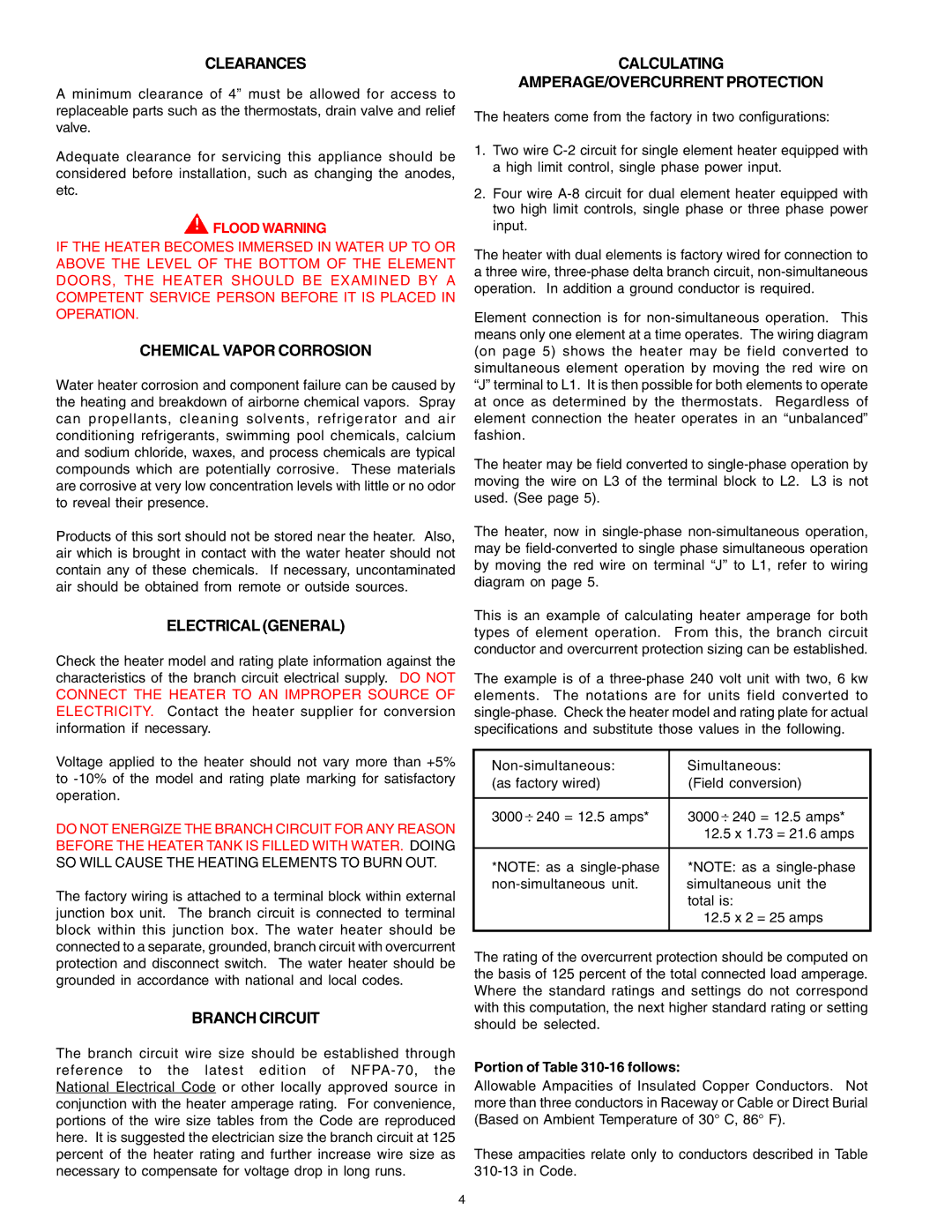CLEARANCES
A minimum clearance of 4” must be allowed for access to replaceable parts such as the thermostats, drain valve and relief valve.
Adequate clearance for servicing this appliance should be considered before installation, such as changing the anodes, etc.
 FLOOD WARNING
FLOOD WARNING
IF THE HEATER BECOMES IMMERSED IN WATER UP TO OR ABOVE THE LEVEL OF THE BOTTOM OF THE ELEMENT DOORS, THE HEATER SHOULD BE EXAMINED BY A COMPETENT SERVICE PERSON BEFORE IT IS PLACED IN OPERATION.
CHEMICAL VAPOR CORROSION
Water heater corrosion and component failure can be caused by the heating and breakdown of airborne chemical vapors. Spray can propellants, cleaning solvents, refrigerator and air conditioning refrigerants, swimming pool chemicals, calcium and sodium chloride, waxes, and process chemicals are typical compounds which are potentially corrosive. These materials are corrosive at very low concentration levels with little or no odor to reveal their presence.
Products of this sort should not be stored near the heater. Also, air which is brought in contact with the water heater should not contain any of these chemicals. If necessary, uncontaminated air should be obtained from remote or outside sources.
ELECTRICAL (GENERAL)
Check the heater model and rating plate information against the characteristics of the branch circuit electrical supply. DO NOT CONNECT THE HEATER TO AN IMPROPER SOURCE OF ELECTRICITY. Contact the heater supplier for conversion information if necessary.
Voltage applied to the heater should not vary more than +5% to -10% of the model and rating plate marking for satisfactory operation.
DO NOT ENERGIZE THE BRANCH CIRCUIT FOR ANY REASON BEFORE THE HEATER TANK IS FILLED WITH WATER. DOING SO WILL CAUSE THE HEATING ELEMENTS TO BURN OUT.
The factory wiring is attached to a terminal block within external junction box unit. The branch circuit is connected to terminal block within this junction box. The water heater should be connected to a separate, grounded, branch circuit with overcurrent protection and disconnect switch. The water heater should be grounded in accordance with national and local codes.
BRANCH CIRCUIT
The branch circuit wire size should be established through reference to the latest edition of NFPA-70, the National Electrical Code or other locally approved source in conjunction with the heater amperage rating. For convenience, portions of the wire size tables from the Code are reproduced here. It is suggested the electrician size the branch circuit at 125 percent of the heater rating and further increase wire size as necessary to compensate for voltage drop in long runs.
CALCULATING
AMPERAGE/OVERCURRENT PROTECTION
The heaters come from the factory in two configurations:
1.Two wire C-2 circuit for single element heater equipped with a high limit control, single phase power input.
2.Four wire A-8 circuit for dual element heater equipped with two high limit controls, single phase or three phase power input.
The heater with dual elements is factory wired for connection to a three wire, three-phase delta branch circuit, non-simultaneous operation. In addition a ground conductor is required.
Element connection is for non-simultaneous operation. This means only one element at a time operates. The wiring diagram (on page 5) shows the heater may be field converted to simultaneous element operation by moving the red wire on “J” terminal to L1. It is then possible for both elements to operate at once as determined by the thermostats. Regardless of element connection the heater operates in an “unbalanced” fashion.
The heater may be field converted to single-phase operation by moving the wire on L3 of the terminal block to L2. L3 is not used. (See page 5).
The heater, now in single-phase non-simultaneous operation, may be field-converted to single phase simultaneous operation by moving the red wire on terminal “J” to L1, refer to wiring diagram on page 5.
This is an example of calculating heater amperage for both types of element operation. From this, the branch circuit conductor and overcurrent protection sizing can be established.
The example is of a three-phase 240 volt unit with two, 6 kw elements. The notations are for units field converted to single-phase. Check the heater model and rating plate for actual specifications and substitute those values in the following.
Non-simultaneous: | Simultaneous: |
(as factory wired) | (Field conversion) |
| | | | | |
3000 | : | 240 = 12.5 amps* | 3000 | : | 240 = 12.5 amps* |
| | | 12.5 x 1.73 = 21.6 amps |
| | | | | |
*NOTE: as a single-phase | *NOTE: as a single-phase |
non-simultaneous unit. | simultaneous unit the |
| | | total is: |
| | | 12.5 x 2 = 25 amps |
| | | | | |
The rating of the overcurrent protection should be computed on the basis of 125 percent of the total connected load amperage. Where the standard ratings and settings do not correspond with this computation, the next higher standard rating or setting should be selected.
Portion of Table 310-16 follows:
Allowable Ampacities of Insulated Copper Conductors. Not more than three conductors in Raceway or Cable or Direct Burial (Based on Ambient Temperature of 30° C, 86° F).
These ampacities relate only to conductors described in Table 310-13 in Code.
